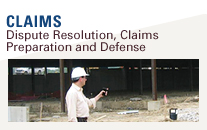 Blog Article – Claim Analysis Case Study
Blog Article – Claim Analysis Case Study
11 November 2016
CONFIDENTIAL ATTORNEY WORK PRODUCT
The information depicted in this document is of a preliminary and incomplete nature. All relevant qualification, facts, and factors are not included. This document is prepared in anticipation of litigation at the direction of and with input of the attorneys assisting the client on the project to which this document relates.
VN Services worked on a delay and disruption claim analysis case with the parties finally reaching a settlement; and I thought I would share some of the story. This discussion won’t get into specifics for the simple reason that the settlement was confidential, so we can’t get into real details. However, I would add that the settlement was exceptionally favorable to our client inferring to me, at least, that the analysis we did had some very real strengths.
We represented a subcontractor that experienced a loss of productivity, additional field conditions costs, and extended field conditions costs. In the world of claims, additional and extended conditions are usually pretty solid claims in terms of being able to quantify them because there are typically labor reports and job cost records for the material, equipment, and labor hours being tracked. You do still have to demonstrate causation and entitlement; but in general, these types of claims tend to be fairly defensible as it was in this particular recent case.
I would like to point out a couple of things regarding the schedule analysis used to support causation and its effects. The CM did such a poor job developing a schedule and accurately updating it that the schedules produced were not particularly useful. Happily, our client did something that I consistently recommend to contractors of all sizes – they kept detailed daily reports. Combined with certified payroll data, our client was able to (painstakingly) put together a daily as-built schedule showing where people were working and how many people were in those locations. It’s difficult to argue against something that detailed.
Loss of productivity is where things always get tricky. No matter what methodology you use, you’re guaranteed to be questioned thoroughly on pretty much every topic and angle related to the loss. This case was no different, but there were some major strengths. The biggest strength was that the client was using an earned value measurement that collected data for each room of the project and included how many pieces were installed. This could then be compared to the estimated labor hours per piece to get to the “earned” labor hours. This calculation showed that field labor was slightly less productive than estimated in the period of time prior to the occurrence of major impacts.
The key here is that, even though a comparison was made to estimated labor hours (Measured Mile analyses typically do not reference the estimate), the calculation at its core is based on actually installed materials. Because of that, we were able to use a very strong Measured Mile methodology comparing the productivity of the “least impacted” period of time versus the impacted period of time. It’s also clever in that it allowed us to calculate an aggregate productivity that included a variety of tasks being done by this contractor.
This comparison was also made possible because the multiple areas of the project had reasonably similar scopes (another requirement of the Measured Mile analysis). Comparing areas or periods of time as part of the Measured Mile is a popular avenue for attack by the opposition. The basic argument usually devolves to saying that any comparison is impossible because the scopes weren’t similar enough. We get it; but, the courts have ruled that the scopes being compared do not have to be identical. I’ll be the first to criticize an analysis that uses ridiculously different scopes for comparison; but again, let’s try to be reasonable.
It’s also well understood that demonstrating the effects and damages of various impacts has to be connected to causation of the impacts. As mentioned earlier, we were fortunate enough to have a sophisticated client that maintained great documentation and data; but we also had access to some seriously damaging documentation from the opposition that was produced through discovery. This documentation helped put together a narrative explanation for how the project was essentially doomed from the beginning by a series of bad decisions made by the Owner based on advice from its construction manager and design team. Those decisions led directly to multiple and almost constant changes in the work flow, which was supported by the daily as-built schedule that was produced that was based on daily reports and timesheets.
Our client, its legal team, and VN Services worked together to demonstrate and connect cause, effect, added costs/damages, and entitlement. At the end of the day, our trip to court was cut short. The parties managed to work out a settlement in mediation that was massively favorable to our client.




